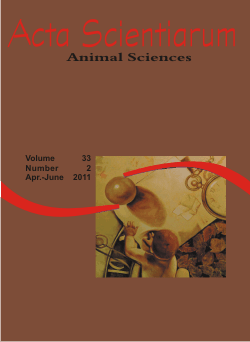<b>Número e peso de perfilhos no pasto de capim-braquiária sob lotação contínua</b> - doi: 10.4025/actascianimsci.v33i2.10438
Resumo
Objetivou-se estudar a relação entre o número e o peso de categorias de perfilhos em pasto de Brachiaria decumbens cv. Basilisk sob lotação contínua com bovinos. O pasto foi manejado com altura média de aproximadamente 25 cm. Foram avaliadas quatro alturas de plantas no mesmo pasto (10, 20, 30 e 40 cm), em delineamento de blocos ao acaso, com duas repetições. Os números de perfilhos vegetativos, vivos e totais reduziram linearmente com a altura da planta. O número de perfilho reprodutivo aumentou de forma linear com a altura da planta (de 8 para 84 perfilhos m-2 quando se comparam plantas de 10 a 40 cm). Os pesos dos perfilhos vegetativos e reprodutivos incrementaram linearmente com a altura da planta. O peso do perfilho vegetativo (0,316 g, em média) foi menor do que o peso do perfilho reprodutivo (0,401 g, em média). A relação entre o número e o peso do perfilho vegetativo foi linear e negativa, enquanto que essa relação, para o perfilho reprodutivo, foi linear e positiva. Em locais com plantas altas há menor número de perfilhos vegetativos, bem como maior número de perfilhos reprodutivos e mortos. Nos locais mais altos do pasto de B. decumbens os perfilhos são mais pesados.Downloads
DECLARAÇÃO DE ORIGINALIDADE E DIREITOS AUTORAIS
Declaro que o presente artigo é original, não tendo sido submetido à publicação em qualquer outro periódico nacional ou internacional, quer seja em parte ou em sua totalidade.
Os direitos autorais pertencem exclusivamente aos autores. Os direitos de licenciamento utilizados pelo periódico é a licença Creative Commons Attribution 4.0 (CC BY 4.0): são permitidos o compartilhamento (cópia e distribuição do material em qualqer meio ou formato) e adaptação (remix, transformação e criação de material a partir do conteúdo assim licenciado para quaisquer fins, inclusive comerciais.
Recomenda-se a leitura desse link para maiores informações sobre o tema: fornecimento de créditos e referências de forma correta, entre outros detalhes cruciais para uso adequado do material licenciado.








































